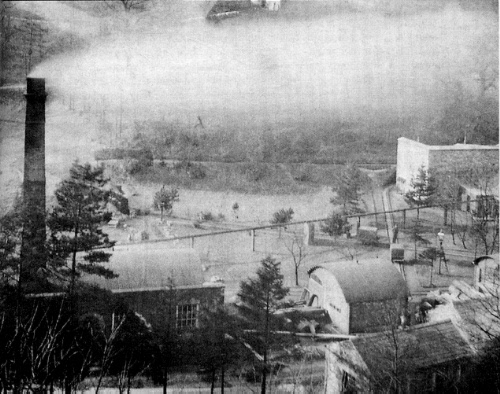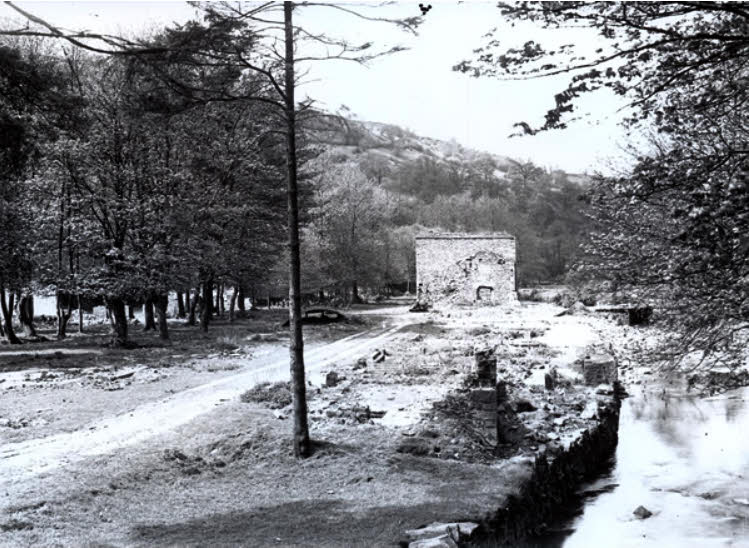Above: I’d guess this photo of workers at the powder mill must have been taken in the early 1900s. It looks like they’re posing with a small water pump for dealing with fires and explosions. But it would take a brave man to tackle a fire in a gunpowder factory!
Above: This 1910 map shows the size of the powder mill (click to expand). It even has its own tramway. I’ve shown the area now under Fernilee Reservoir in blue.
All photos on this page come from the Whaley Bridge Local History Group. Click them to view larger images.
Above: The entrance to the powder mill – I think coming from Goyt’s Bridge (although I’m not sure).
Below: This photo shows the mill in full production, with the chimney belching smoke and a wagon on the tramway. I’m not sure what the raised line is going across the photo.
Above: Demolition of the mill buildings was well underway in this photo, taken in the early 1930s. The River Goyt flows to the right.
Above: George Raven was one of three men killed by an explosion in 1909. He and another victim, Joseph Hill, are in the group photo (above right).
The largest employer in the Goyt Valley was the gunpowder mill, the ruins of which now lie submerged under the waters of Fernilee Reservoir (see map left). At one stage over 100 men worked here.
It was an ideal site for such a potentially dangerous factory, with plentiful water-power provided by the River Goyt. And far enough away from nearby villages to minimise damage when there was the inevitable accidental explosion.
It does seem that accidental explosions were far from uncommon – often with fatal results to the unfortunate workers. Newspaper reports throughout the 1800s show that it could be a very dangerous place to work.
The Whaley Bridge Local History Group has collected a whole series of these reports on their website (click here to view). Here are two typical examples, the first from The Stockport Advertiser in May 1836;
We are sorry to state that an explosion took place at the Powder Mills, at Fernilee, this morning, about seven o’clock, in the stoving house, by which two unfortunate creatures were in one moment deprived of their existence.
And less than two weeks later, the Macclesfield Courier reported another explosion in gruesomely sensational style;
On Thursday week, about six o’clock in the morning, one of the most dreadful accidents which we have ever had to record, occurred at Shallcross, in the County of Derby, about eight miles from Macclesfield. The powder mills of Messrs Williamson, which contained at the time a ton and a half of gunpowder, blew up with a tremendous explosion.
George Heaps, a married man, with a wife and four children, who was in the mill at the time, was blown a distance of six hundred yards, to his master’s farm at Taxal, in this county, Shallcross being on the border of Cheshire and Derbyshire. He was, of course, quite dead when found.
Mr Hollins, the coroner for Cheshire, held an inquest on his body the very day that the poor man’s youngest child was baptized.
The persons who went in search of him when very near him observed something, which had not the most resemblance to a human body; but on going up they discovered that it was the miserable object of which they were in search. The clothes and the hair of his head were completely burnt off him, and the body almost reduced to a cinder.
One of his legs had been torn off and has not at present been found. John Heaps, a single man, and the brother of George, was found in the ruins of the mill, with his clothes and hair burnt off, but still alive. He died, however, the day following in the greatest agony.
Above: A group of mill managers and staff pose for the camera. The chap dressed in white sporting a straw bowter is an odd contrast with the workers to his left!
It seems the mill’s history dates back to 1801. It was taken over by the Chilworth Gunpowder Company in 1888. And ceased production in 1921 – some 15 years before the construction of Fernilee Reservoir. I found this copy of a letter on the Whaley Bridge Local History website, written to the editor of the Buxton Advertiser in 1921;
On the 13th January, 1801, Peter Knowles, farmer, of Lymm, in Cheshire, and Thomas Williamson, millwright, of Fernilee, Derbyshire, applied at Derby Quarter Sessions for a license or authority to erect gunpowder mills, and such licence was granted on the above-mentioned date.
The two men obtained a lease for 42 years from the 25th March 1801, and then proceeded to erect the nucleus of the present extensive works at Fernilee held by the Chilworth Gunpowder Company, of Godalming, in Surrey, for the last 22 years.
The work of dismantling the works – owing to the capture of the African market for gunpowder by American firms – has been proceeding for some months, and was completed on the 25th March last, or exactly 120 years after the granting of the original lease.
The paragraph in a Manchester paper about gunpowder being sent from the Goyt Valley for use by ships engaged in the fight against the Spanish Armada has evidently been inspired by the same gentleman who recently intimated that the new and massive chimney at the Gunpowder Factory, 90 feet in height, has been sold for telescopic use to the Lick Observatory in the United States.
The dismantling of the works has caused a considerable displacement of labour in the Goyt Valley, and a valuable works site with immense water power is rendered unoccupied.
Above: Taken during the construction of the reservoir (note the cranes in the distance), this early 1930s photo shows the size of the mill works, with the small tramway line in the foreground.
Gerald Hancock mentions the mill in his ‘Goyt Valley Romance’ book;
The Gunpowder Mill ceased production in 1920 and the ruins are in a watery grave beneath Fernilee reservoir, towards the dam wall end. In times of drought some of the ruins can be glimpsed, as in its day the works were quite substantial.
The works were started by Thomas Williamson to serve mines and quarries in the area. Before this, mines in the area had to import their gunpowder for blasting by rail from other parts, and the cost was becoming prohibitive.
Though the actual date is unknown, the land for the ‘Powder Mill’, as local people knew it, was acquired from Francis Jodrell Esq., in about 1800. Over the years it provided work for many people in the locality, but the mill was the scene of frequent accidents, although the dangers of working with gunpowder were well appreciated.
Series of tramways were employed throughout the works to transport materials, and the magazine was sited some distance away at the end of its own track. There had been an accident in the 1880’s when a woman worker had been killed, but one of the worst accidents recorded was the huge explosion in 1909 when three men were killed.
Their names were, Joseph Hill, aged 32, George Raven (above left), aged 26, and Percy Southern, aged 18. Joseph Hill was killed instantly and Raven and Southern died later of their injuries in Buxton Hospital. The inquest heard from an official that a possible piece of grit, or metallic object had caused the blast.
Page update: July 2019
The 1878 legal agreement confirming the sale of the mill for £3000 has turned up on eBay (click to enlarge). The description says…
1878 Rare Original Sale Agreement from James Hall Williamson, FERNILEE GUNPOWDER WORKS, Near Buxton, Derbyshire, signed over two Revenue stamps, being the agreement to sell all Plant, Stock in Trade, Goodwill, Railway Van and all other appurtances belonging to the Fernilee Powder Mills for the sum of £3000 – to Edward Hall, G.W.Higinbotham, George Goodwin, Arthur Sheldon, John Sheldon, Frederick Sheldon, and with receipt at bottom of SIX POUNDS on account.
The seller also includes this brief history of the mill;
FERNILEE On the River Goyt near the village of Fernilee, 8 km north-west of Buxton, but now submerged beneath Fernilee Reservoir. A building from the factory survives at Windgather Youth Hostel.
The factory was established by Thomas Williamson in 1801 . Derbyshire directories show that it remained in the Williamson family until the late 1880s. It was then acquired by the Chilworth Gunpowder Company Limited whose original factory was at CHILWORTH in Surrey (Chilworth Gunpowder Company Annual Report 1889).
The works employed 120 men just before the First World War (Peak National Park 1977).
Chronology…
- 1801 Licence granted to Thomas Williamson. 1846 Thomas Williamson and Joseph C Buxton proprietors.
- 1871 James Williamson of Fernilee Hall, gunpowder manufacturer, listed in census return.
- 1876 Continuing Certificate no. 15.
- c.l888 Acquired by Chilworth Gunpowder Company.
- 1918 Explosives Trades.
- 1920 Closed (Patterson 1986).
- 1938 Fernilee dam built (Peak National Park 1977).








